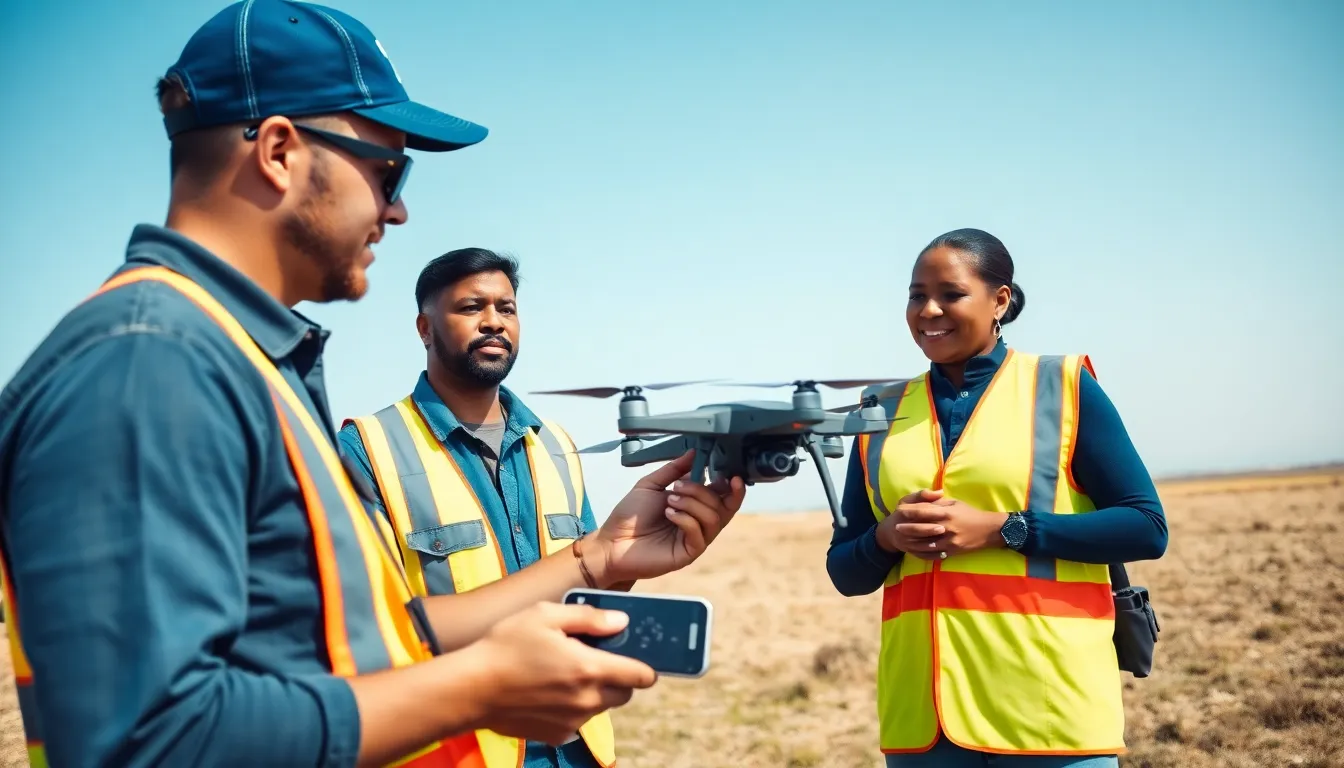In a world where drones are the new superheroes of the skies, mastering their flight isn’t just a hobby—it’s a necessity. Whether you’re aiming to capture breathtaking aerial shots or deliver tacos faster than your local restaurant, drone training manuals are your trusty sidekicks. They’re like the GPS for your drone journey, guiding you through the twists and turns of piloting with ease.
Imagine soaring through the clouds, feeling like a tech-savvy wizard, all while knowing you’ve got the know-how to avoid those pesky tree branches. With the right manual in hand, anyone can become a drone whisperer. So buckle up and get ready to dive into the fascinating world of drone training manuals, where learning meets laughter and every chapter takes you a step closer to aerial mastery.
Table of Contents
ToggleOverview of Drone Training Manuals
Drone training manuals serve as essential resources for individuals seeking to master piloting skills. These manuals provide comprehensive information about drone operation, safety guidelines, and maintenance procedures. They often include step-by-step tutorials that cover various aspects such as pre-flight checks, in-flight controls, and post-flight analysis.
Users find diagrams and illustrations helpful for visualizing complex concepts. Many training manuals also feature practical exercises that allow learners to apply their knowledge in real-world scenarios. Videos and online resources often supplement the text, enhancing the learning experience.
Guidance on regulations and best practices is another crucial component of these manuals. Knowing local laws ensures that operators comply with aviation regulations and operate their drones responsibly. Various sections often discuss specific applications of drone technology, such as commercial use, surveying, and search-and-rescue operations.
In addition to technical skills, training manuals emphasize the importance of understanding the drone’s capabilities. Familiarity with flight modes, battery management, and navigation systems contributes to safer and more effective drone operation.
Some manuals also highlight emerging technologies in the drone industry. Knowledge about advancements, like obstacle avoidance sensors or autonomous flight systems, keeps operators informed and competitive.
Effective drone training manuals cater to a range of skill levels. Beginners appreciate simplified instructions while experienced pilots benefit from advanced techniques and strategies. The blend of theoretical concepts and practical tips makes these manuals valuable tools for anyone interested in becoming proficient in drone operation.
Importance of Drone Training Manuals

Drone training manuals serve as crucial resources for effective piloting. These guides enhance understanding of aircraft operation and safety while ensuring compliance with important regulations.
Safety Considerations
Safety remains a top priority in drone operation. Manuals provide clear instructions on pre-flight checks, emergency protocols, and safe landing techniques. Operators learn to identify and mitigate potential hazards. Understanding how to fly responsibly reduces risks to people, property, and the environment. Well-structured training manuals also include guidelines for maintaining the drone. Regular maintenance decreases the likelihood of technical failures during flight.
Compliance with Regulations
Following regulations is essential for legal drone operation. Comprehensive training manuals outline local, state, and federal laws. They inform operators about necessary certifications and permissions required for various uses. Manuals often highlight the importance of proper airspace awareness, ensuring pilots avoid restricted zones. Familiarity with these regulations leads to responsible flying practices. Moreover, complying with laws fosters public trust and safety in drone technology.
Types of Drone Training Manuals
Drone training manuals come in various types, each designed to cater to specific skill levels and learning goals. Understanding these options helps aspiring drone operators choose the right manual for their needs.
Beginner Manuals
Beginner manuals focus on essential concepts for novice pilots. These guides introduce basic drone operations, terminology, and functionality. Learners find step-by-step instructions for familiarizing themselves with controls. Many manuals include diagrams for visual learners and practical exercises to build confidence. Safety protocols are highlighted, ensuring new operators grasp the importance of pre-flight checks and emergency procedures. Compliance with local regulations is also emphasized, helping beginners develop responsible flying habits from the start.
Advanced Manuals
Advanced manuals target experienced operators seeking to enhance their skills. These resources delve into complex maneuvers, aerial photography techniques, and advanced flight planning. Detailed discussions on software applications for drone management provide insights into optimizing performance. Many manuals cover troubleshooting strategies for overcoming common issues, equipping pilots to handle unexpected challenges. In addition, they include sections on integrating drones into professional workflows, addressing legal requirements for commercial use. Mastery of these advanced topics fosters greater confidence and competence in skilled drone operators.
Key Components of Effective Drone Training Manuals
Effective drone training manuals focus on specific components that enhance learning and operational proficiency. Clear instructions and visual aids play significant roles in ensuring students grasp concepts easily.
Clear Instructions
Clear instructions provide essential guidance for new and experienced pilots. Each step should detail the operational processes involved in flying drones. This clarity aids in understanding complex maneuvers and operational protocols. When manuals outline safety procedures, users can confidently execute pre-flight checks and emergency measures. Consistent formatting and straightforward language enhance comprehension. Providing examples can illustrate the correct application of concepts, reinforcing learning efficacy.
Visual Aids and Diagrams
Visual aids and diagrams significantly enhance the learning experience. Well-placed images can clarify operational steps and technical terminology. Diagrams highlight key components of drones and their functions, offering quick reference points. When students visualize maneuvers through annotated figures, they can better internalize information. These aids reduce the cognitive load on learners, making information more digestible. Charts or infographics summarizing regulations or safety protocols further streamline compliance understanding. Visual elements effectively bridge gaps in written instructions, ensuring thorough comprehension.
Best Practices for Creating Drone Training Manuals
Creating effective drone training manuals requires several best practices to enhance learning and comprehension.
Clear organization remains essential for guiding users. Sections should flow logically, with a focus on progressing from basic to advanced concepts.
Incorporating visuals like diagrams and charts boosts understanding. Visual elements clarify processes and assist in retaining complex information.
Using concise language helps reduce confusion. Manuals should avoid jargon wherever possible, ensuring all readers grasp the material easily.
Integrating practical exercises fosters hands-on experience. Including challenges allows learners to apply theoretical concepts in real-world scenarios.
Safety guidelines must feature prominently throughout the manual. Each section should outline pre-flight checks, emergency procedures, and landing protocols, thus reinforcing safety as a priority.
Regular updates keep the content relevant. As regulations and technologies evolve, refreshing the manual ensures adherence to current standards.
Incorporating user feedback enhances manual effectiveness. Listening to learners’ experiences leads to improvements that address common difficulties or questions.
Providing checklists offers quick reference points. Checklists streamline processes and serve as handy tools for both beginners and advanced operators.
Including case studies exemplifies best practices in action. Real-life examples illustrate successful drone operations and reinforce key lessons.
Ultimately, these practices contribute to comprehensive and user-friendly manuals, empowering drone operators to achieve proficiency in their skills.
Drone training manuals serve as invaluable resources for anyone looking to master the art of flying. They not only provide essential information on operation and safety but also foster a deeper understanding of the legal landscape surrounding drone use. By offering structured guidance tailored to various skill levels these manuals empower users to navigate their drone journey with confidence.
With a focus on clear instructions and practical exercises they enhance the learning experience significantly. As technology evolves staying updated with the latest practices and regulations becomes crucial. Engaging with these manuals ultimately leads to more skilled and responsible drone operators contributing positively to the growing field of drone technology.



